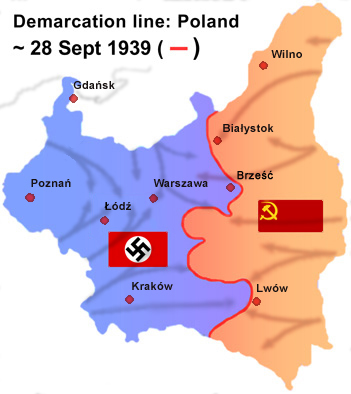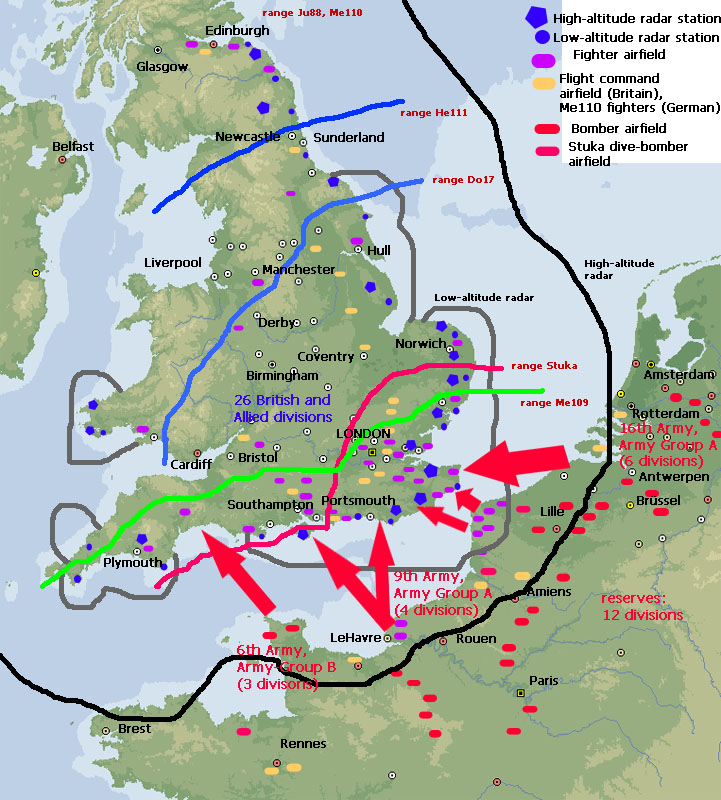The links below will help you with translating tools between English and Spanish.
1. Audio of a words in both English and Spanish. Will also translate phrases.
2. Google Search - Espana: The word can be typed in English, and the search finds results in Spanish, including images
3. Also Google Arabic is available.
2. Google Search - Espana: The word can be typed in English, and the search finds results in Spanish, including images
3. Also Google Arabic is available.
****************
This post has information about major events during WW II. These events are called TURNING POINTS because they show when major things happened that show the war was moving in a different way than it had before. For the most part they will be in chronological order (the order in which they happened). Some happened in the European area of the war, and some happened in the Pacific area of war.



European area of war

Pacific area of war
The events in this part (Module 7 - Part 1) we go from the German Invasion of Poland in 1939, up to the Battle of Midway in 1942.
German Invasion of Poland
(European area of war) September 1st, 1939
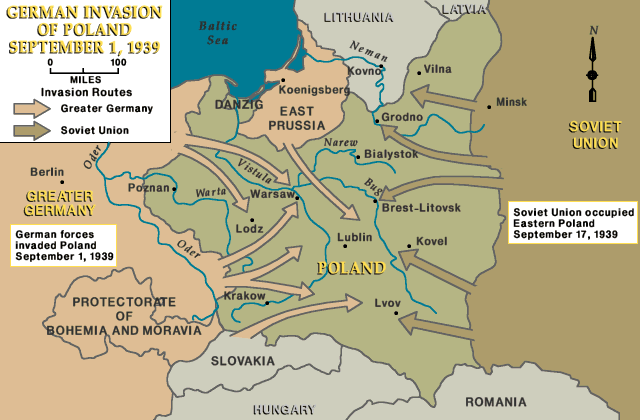
Map of Invasion of Poland

Map of Invasion of Poland
The Invasion of Poland, also known as the September Campaign or 1939 Defensive War was an invasion of Poland by Germany and the Soviet Union that marked the start of World War II in Europe. In a defensive war you say you are doing it because someone attacked you first, and this is what Germany said had happened, but it was a lie.
Germany did not want to be blamed for starting the war, so they got some dead bodies from one of their Concentration Camps.
They then went to a radio station in Germany right on the border with Poland. They dressed the bodies in Polish uniforms and spread them around. Then they pretended like they were the Polish attacking the radio station.

Gleiwitz radio station where the Germans faked an attack
The next day, on September 1st, 1939, the Nazis invaded Poland.
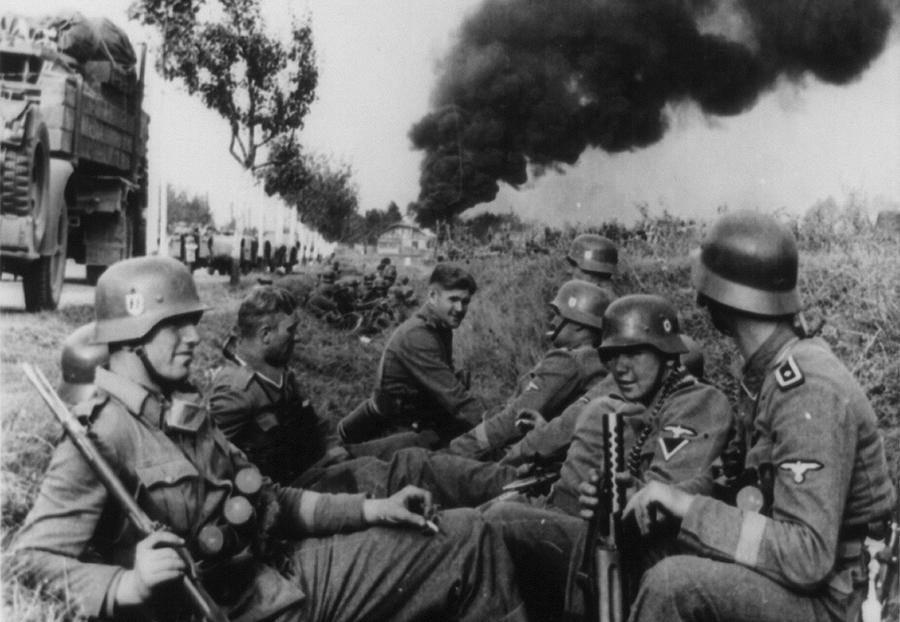
Germans taking a rest while they are invading
They did not do it alone. Even though the Germans hated the Communists in The Soviet Union they had made a secret agreement with the Soviets to attack and split up Poland. Germany came from the West on September 1st, and the USSR ( Soviets) came from the East 16 days later.
The arrows show where each side came from, and how far they went. the flags show who came from which side. The red line shows where they had agreed to stop. Why would either side make this agreement if they knew they would be fighting each other soon???
It would prove to be a short war, as the Germans had completed their victory by October 6th, 1939 (That was only 35 days.).Germany would take over the Western part of Poland, and the USSR would take over the Eastern part.

Germany was able to do this so quickly because they used a new way of war called Blitzkrieg. It is when you send your planes over an enemy, and your fast moving tanks through and around them. Then your foot soldiers follow. Blitzkrieg means “Lightening War” because it moves so fast.


Map showing how Poland was divided
Germany was able to do this so quickly because they used a new way of war called Blitzkrieg. It is when you send your planes over an enemy, and your fast moving tanks through and around them. Then your foot soldiers follow. Blitzkrieg means “Lightening War” because it moves so fast.

German planes, tanks,and soldiers working together in a blitzkrieg attack
The sad thing is what happened in Poland after the fighting was over. The way the Germans thought and would act was supported by something their leader, Hitler, said before the attack was started.
When you get to this point come and discuss this with your teacher

German soldiers cutting the beard of a Jewish man. It was part of their religious beliefs that they were to have beards. Why do YOU think the Germans did this?
When the war was over six years later 2,700,000 Jews who were alive in Poland when the war started had been murdered. That is 90%.
Poland: The skull symbols show where the Germans had extermination camps where they took Jews to murder them
German Invasion of France and Capture of Paris: May, 1940
Adolph Hitler had planned to invade other countries in Europe, and wanted to do it right after winning in Poland. However it did not work out that way. The Invasion of those other countries had to wait. Then it happened fast. The Germans went into The Netherlands (Holland) and Belgium in May of 1940.
The arrows show the paths followed by the Germans
The reason they did it this way was so they could get to France by going around the French forts instead of through them. Again they used their Blitzkrieg plan.
France's capital of Paris was captured by the Germans on 14 June, 1940. On 22 June, an agreement to surrender was signed between France and Germany.
This is how the German celebrated:
Once the Germans defeated France they set their sites on Great Britain. This picture shows what a German bombardier (person whose job was to decide when and where to drop the bombs) would have seen as they were deciding where to drop their bombs.
The Germans had planes less than 25 miles from England at bases in captured France. They had bases in other areas of Europe they had captured, including Denmark and Norway. They close enough to hit many targets in Great Britain .
Great Britain (United Kingdom) is on the left. The red arrows show the paths the Germans used when attacking. The small red shape are places where the Germans had their planes.
The British leader, Winston Churchill, gave a speech to encourage his people where he said:
First the Germans tried to hurt Great Britain by bombing places called docks where ships brought supplies for the people and the army (Clip from movie showing this.). They thought that if they did this it would stop those supplies from coming in, and Great Britain would be weak when the Germans invaded with soldiers on foot. It caused a lot of damage, but did not work.
British docks (where ships come in and out) that have been hot by German bombs
Next the Germans tried to go after the British Fighter Plane Bases and Radar Bases (Radar was a tool that let the British see the Germans coming WAY before they got there.). They did this because those were the weapons that were allowing the British to keep stopping the German planes from having total success. The planes would have fights in the air called “dog fights.” (Clip showing a dogfight from a movie) This clip shows an actual dogfight, with a German pilot jumping out of his plan after getting it shot up.)
British pilots running to their planes to go shoot down Germans
Eventually they would engage in “Terror Bombing” against the people living in London. That part was called “The Blitz.”
In the end the British did not give up, and the Germans stopped their attacks by air on October 31st, 1940, and never attacked by land.
Winner??? - Great Britain!
Lend-Lease Program: March, 1941
In module 5 you learned how the U.S. gave war supplies to Great Britain, France, China, and the Soviet Union. This was known as the Lend-Lease program, because we were “lending” them the supplies even though we really knew we would not get them back. In return one of the countries, Great Britain, leased (rented to us) some military bases in the area of the Caribbean Sea.
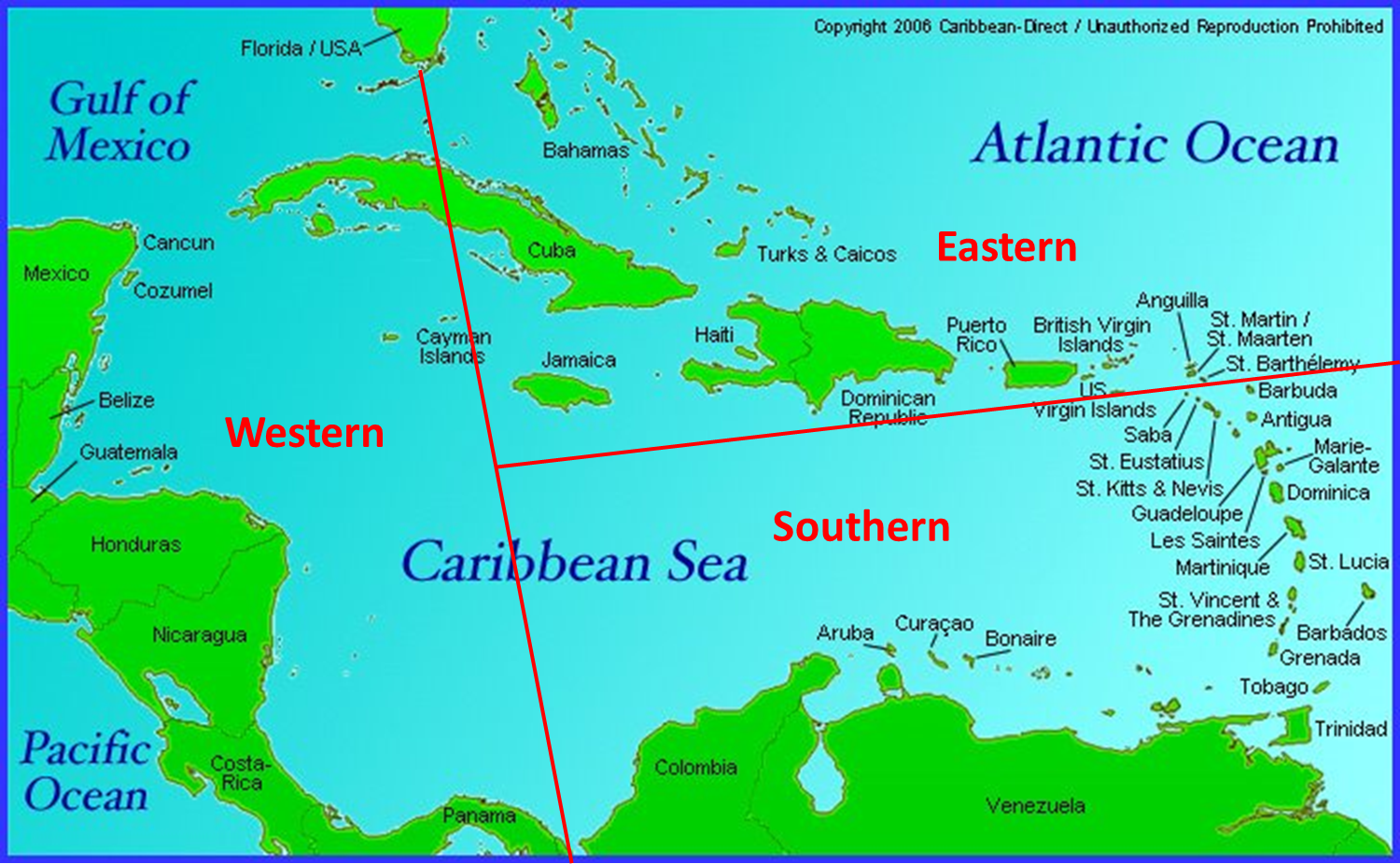
See the tip of Florida at the top of the map, and many other countries on the left.
This gives a basic understanding of why Lend-Lease had to happen :
In July 1940, after Britain had lost 11 navy ships to the Germans over a 10-day period. The newly elected British Prime Minister Winston Churchill requested help from U.S. President Roosevelt. Roosevelt said he would give Great Britain 50 navy ships we were not using just then if Great Britain would let us rent British bases in the Caribbean and Newfoundland.
The plan started on March 11, 1941.
The reason we did this was because we wanted to help those countries with which we were friendly fight against Germany. The way we were able to supply all of these countries with all of the supplies was because all of the massive factories all over the United States were now not making radios, washing machines, and cars, but instead were making guns, war ships, and many other weapons. The program lasted from 1941 to the end of the war in 1945.
Japanese Bombing Of Pearl Harbor – December 7th, 1941
The story that explains all of this was shared in Module 6. The United States was unprepared for the attack because we were not at war with Japan. Many of our ships were heavily damaged (hurt).
Germany Declaring War on the United States: December 11th, 1941
Germany declared war against the U.S. due to the fact they were partners with Japan in the alliance called the Axis Powers. Two of those leaders were Adolph Hitler and Benito Mussolini.


Hitler and Mussolini
United States Declares War on:
Japan (December 8th, 1941) and Germany (December 11th, 1941)
Japan (December 8th, 1941) and Germany (December 11th, 1941)
The U.S. declared war on Japan because they attacked us. We declared war Germany because they declared war on us.
Battle of Midway: June 4th-7th, 1942
The United States was hurt a lot at Pearl Harbor.

Pearl Harbor Damage
Soon after that attack the Japanese also attacked us at The Philippines on December 8th, 1941, the day after Pearl Harbor. They finally defeated us there on the 8th of May, 1942.
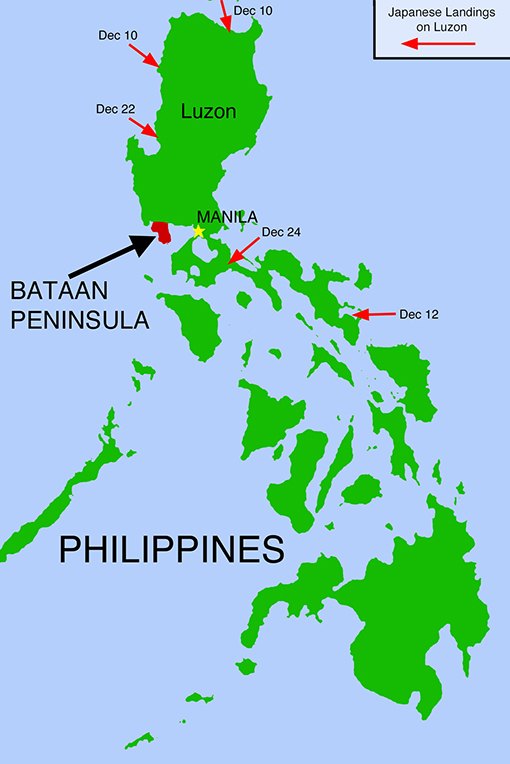
The Japanese landed all over (see red arrows), and soon had pushed us to just that little place in red, the Bataan Peninsula.
Things were not looking good for the United States in the war in The Pacific.
Between May 4th and 8th we and the Australians fought a battle at sea against the Japanese Navy. It was in an area of the Pacific called The Coral Sea.

The place where this fight happened is near Australia
The Japanese destroyed more of our ships and airplanes than we destroyed of theirs. However, we stopped the Japanese plan to invade Australia. It was kind of a draw (nobody won).

The place where this fight happened is near Australia
The Japanese destroyed more of our ships and airplanes than we destroyed of theirs. However, we stopped the Japanese plan to invade Australia. It was kind of a draw (nobody won).
This set the stage for what would happen two months later near a little island in the middle of the pacific controlled by The United States called Midway Island.

See Midway Island to the North and West of Hawaii
What Happened:
Japanese commander Admiral Isoroku Yamamoto moved toward Midway to try to get the U.S. ships to follow and attack him. He thought he was so much more powerful that he could destroy the U.S. Navy's aircraft carriers.
U.S.S. Enterprise aircraft carrier. See the planes on her deck?
Yamamoto's surprise was ruined by American communications information (intelligence), which figured out his plan well before the battle started. This allowed Admiral Chester W. Nimitz, the U.S. Pacific Fleet commander, to set an ambush (where you sneak up on someone and attack them). On 4 June 1942, the fight started.
At 0430 (4:30 AM) in the morning of 4 June 1942, still 240 miles away from Midway Island, Japan launched 108 attack planes from their four aircraft carriers to attack the U.S. base at Midway Island.
What the Japanese did not know was that there were three U.S. aircraft carriers only 215 miles from the Japanese ships. The two opposing fleets (groups of navy ships) sent out search planes to try to find each other. Seaplanes (planes that could land on water) from Midway were also patrolling along the expected Japanese attack path. One of these spotted, and reported, the Japanese ships at about 0530 (5:30 am).
What the Japanese did not know was that there were three U.S. aircraft carriers only 215 miles from the Japanese ships. The two opposing fleets (groups of navy ships) sent out search planes to try to find each other. Seaplanes (planes that could land on water) from Midway were also patrolling along the expected Japanese attack path. One of these spotted, and reported, the Japanese ships at about 0530 (5:30 am).
Ships and a plane of the U.S. Pacific Fleet
Remember, the Japanese, not knowing the U.S. Aircraft carriers were so near, were attacking the Midway Island. They did some damage to buildings on the island. Midway had U.S. airplanes, which attacked the Japanese ships, and were mostly shot out of the air and crashed.
The leaders of the U.S. navy ships decided they had to attack right away before the Japanese found them. They could not send all of their planes, but they sent the ones that were ready to go. They were torpedo planes (planes that can launch a torpedo from their belly. They are about to fold down the wings on this plan so it can take off and attack the Japanese.)
Soon our torpedo planes (This picture is from about 7:30 am, 4 June 1942, the morning of the attack) attacked the Japanese ships. EVERY ONE of them was destroyed. Not a single U.S. torpedo hit a Japanese ship. All 15 U.S planes in the attack were shot down by Japanese fighter planes, killing all pilots.
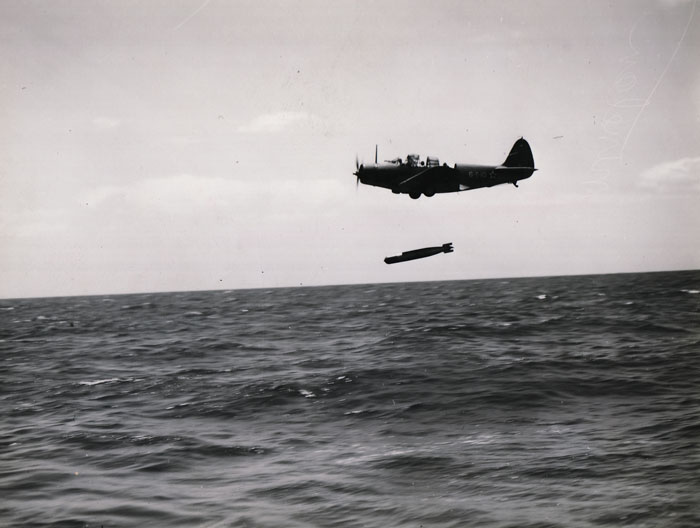
U.S. torpedo bomber. They dropped their torpedo into the water so it would go under water and hit an enemy ship
Those men’s lives were not wasted, because the Japanese planes protecting their ships were now out of gas and bullets, so they had to land to get more. The Japanese planes that had attacked the island were also getting more fuel, bombs, and bullets.
Then, when the Japanese heard that our aircraft carriers (ships that have planes on them) were near they started putting torpedoes on their planes to attack the ships, instead of more bombs to attack the island again. What this all means is that the Japanese were taking a LOT of time, and had all kinds of gas, bullets, bombs, and torpedoes sitting around on the deck their ships. The deck is the flat top where planes land and take off.
U.S. dive bomber aiming for Japanese ships
Why was that such a big deal? Well, what do YOU think would happened when bombs start hitting a place where there is a lot of gas, bullets, bombs, and torpedoes sitting around? Right, large BOOMS!!!
Movie scene of U.S. dive bombers hitting Japanese aircraft carriers
Mitsuo Fuchida, the Japanese pilot who led the attack on Pearl Harbor, was on the Akagi when it was hit, and described the attack:
“A look-out screamed: "Hell-Divers!" I looked up to see three black enemy planes plummeting towards our ship. Some of our machine guns managed to fire a few frantic bursts at them, but it was too late. The plump silhouettes of the American Dauntless dive-bombers quickly grew larger, and then a number of black objects suddenly floated eerily from their wings.”
| |
When the fighting was finally over on June 6th, 1942 we had sunk 4 of the most important Japanese aircraft carriers.

Japanese carrier Hiryu burning before sinking
One of the U.S. aircraft carriers, the USS Yorktown, was so badly damaged that she sank. Look here for a picture of what she looks like on the bottom of the ocean 16,650 feet down. That is over 3 miles.
Control tower and guns of USS Yorktown on bottom of Ocean today. Right now.
Why was The Battle of Midway such a BIG Turning Point???
Prior to this fight, Japan had a HUGE navy advantage over the United States and could usually pick where and when to attack. After Midway, the we were pretty much equal in power with the Japanese. This allowed US to soon start attacking the Japanese instead of sitting around waiting for them to hit us. Eventually we were stronger than the Japanese.

